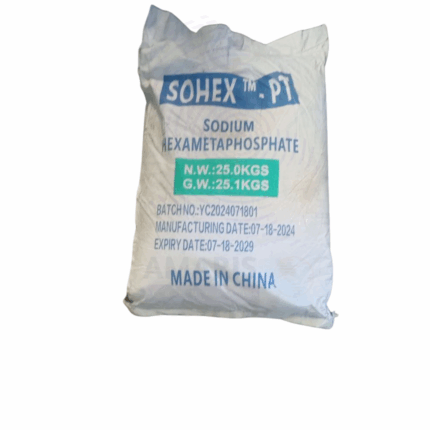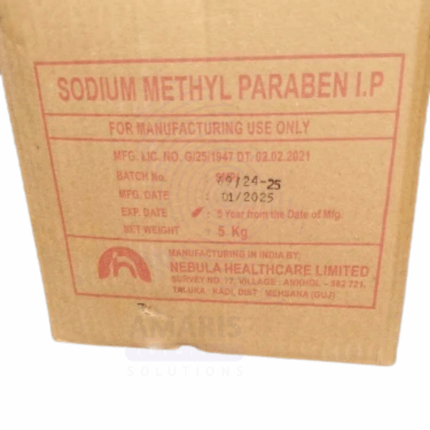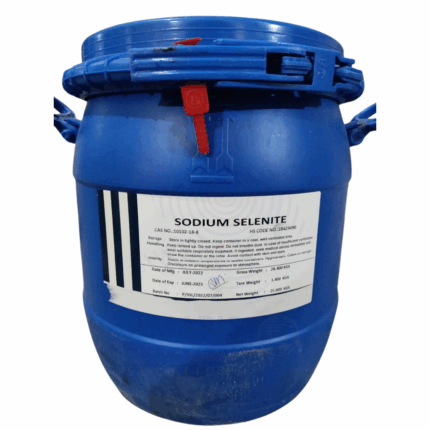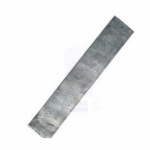
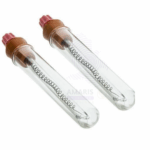
Tobramycin Sulphate USP
Tobramycin Sulphate USP is a purified, water-soluble sulfate salt of tobramycin, an aminoglycoside antibiotic. It exhibits potent bactericidal activity against a broad spectrum of aerobic Gram-negative bacteria, including Pseudomonas aeruginosa, and certain Gram-positive bacteria. This pharmaceutical-grade compound is primarily used to treat severe infections such as respiratory tract infections, urinary tract infections, and septicemia. Tobramycin Sulphate USP is commonly formulated for injectable, inhalation, and ophthalmic applications, ensuring effective systemic and localized antimicrobial therapy.
Primary Uses
Pharmaceutical Industry
Injectable Antibiotic Formulations: Treatment of serious bacterial infections including pneumonia, septicemia, and intra-abdominal infections.
Inhalation Therapy: Management of chronic Pseudomonas aeruginosa lung infections, especially in cystic fibrosis patients.
Ophthalmic Preparations: Treatment of bacterial conjunctivitis, keratitis, and other eye infections.
Topical Antibiotics: Used in creams and ointments for skin infections and burns.
Secondary Uses
Veterinary Medicine
Used for treating bacterial infections in animals, particularly respiratory and urinary tract infections.
Research & Development
Employed in pharmaceutical R&D for antibiotic efficacy studies and formulation development.
Combination Therapies
Used in combination with other antibiotics to prevent resistance and enhance antimicrobial spectrum.
Basic Identification Attributes
Chemical Name (IUPAC): (2S,3R,4S,5S,6R)-4,5-diamino-2-(aminomethyl)-6-(methylamino)oxane-3,5-diol sulfate (2:1)
Common/Trade Name: Tobramycin Sulphate USP
CAS Number: 32986-56-4
HS Code: 2941.10.00
Synonyms: Tobramycin sulfate, Tobramycin salt
Physical & Chemical Properties
Physical State: White to off-white crystalline powder
Color & Odor: White; odorless to slight ammoniacal odor
Melting Point: Approximately 218-223 °C (decomposes)
Solubility: Highly soluble in water; practically insoluble in alcohol and organic solvents
pH of Solution: Typically 5.5 - 7.0 (1% aqueous solution)
Density: Approx. 1.5 g/cm³
Safety & Hazard Attributes
GHS Classification:
Not classified as hazardous under normal handling, but antibiotic powders may cause sensitization.
Toxicity: Nephrotoxic and ototoxic at high doses or prolonged use; requires therapeutic monitoring.
Exposure Limits: No specific occupational exposure limits; use safe handling practices to avoid inhalation or skin contact.
Storage & Handling Attributes
Storage Conditions: Store in a cool, dry place below 25 °C, protected from light and moisture.
Container Type: Sealed, moisture-proof containers or packaging.
Shelf Life: Typically 24-36 months under proper storage.
Handling Precautions: Use gloves and dust masks; avoid inhalation and prolonged skin contact.
Regulatory & Compliance Attributes
Complies with USP standards for identity, purity, potency, and quality.
Manufactured under Good Manufacturing Practices (GMP).
Listed in major pharmacopeias including USP, BP, EP.
Complies with FDA and international drug regulatory requirements.
Suitable for use in human and veterinary medicinal products.
Environmental & Health Impact
Biodegradability: Readily biodegradable under aerobic conditions.
Ecotoxicity: Moderate toxicity to aquatic organisms; avoid environmental release.
Bioaccumulation: Not significant.
PPE Required: Gloves, protective clothing, dust masks or respirators recommended.
Handling Guidelines: Avoid dust generation; work in well-ventilated areas or under fume hoods.
Storage Measures: Keep containers tightly sealed to prevent moisture ingress.
First Aid Measures
Inhalation: Move to fresh air; seek medical attention if respiratory irritation occurs.
Skin Contact: Wash affected area thoroughly with soap and water.
Eye Contact: Rinse immediately with plenty of water for at least 15 minutes; seek medical advice if irritation persists.
Ingestion: Rinse mouth; obtain immediate medical attention.
Firefighting Measures
Fire Hazards: Not combustible but may decompose under fire to emit toxic fumes.
Extinguishing Media: Use water spray, foam, dry chemical, or CO₂ extinguishers.
Hazardous Combustion Products: May produce nitrogen oxides (NOx), sulfur oxides (SOx), and other toxic gases.


 Preservatives(food)
Preservatives(food) Flavor Enhancers
Flavor Enhancers Acidulants
Acidulants Sweeteners
Sweeteners Antioxidants
Antioxidants Colorants(food)
Colorants(food) Nutraceutical Ingredients (food)
Nutraceutical Ingredients (food) Nutrient Supplements
Nutrient Supplements Emulsifiers
Emulsifiers
 Collectors
Collectors Dust Suppressants
Dust Suppressants Explosives and Blasting Agents
Explosives and Blasting Agents Flocculants and Coagulants
Flocculants and Coagulants Frothers
Frothers Leaching Agents
Leaching Agents pH Modifiers
pH Modifiers Precious Metal Extraction Agents
Precious Metal Extraction Agents
 Antioxidants(plastic)
Antioxidants(plastic) Colorants (Pigments, Dyes)
Colorants (Pigments, Dyes) Fillers and Reinforcements
Fillers and Reinforcements Flame Retardants
Flame Retardants Monomers
Monomers Plasticizers
Plasticizers Polymerization Initiators
Polymerization Initiators Stabilizers (UV, Heat)
Stabilizers (UV, Heat)
 Antifoaming Agents
Antifoaming Agents Chelating Agents
Chelating Agents Coagulants and Flocculants
Coagulants and Flocculants Corrosion Inhibitors
Corrosion Inhibitors Disinfectants and Biocides
Disinfectants and Biocides Oxidizing Agents
Oxidizing Agents pH Adjusters
pH Adjusters Scale Inhibitors( water)
Scale Inhibitors( water)
 Antioxidants(cosmetic)
Antioxidants(cosmetic) Emollients
Emollients Fragrances and Essential Oils
Fragrances and Essential Oils Humectants
Humectants Preservatives
Preservatives Surfactants(cosmetic)
Surfactants(cosmetic) Thickeners
Thickeners UV Filters
UV Filters
 Fertilizers
Fertilizers Soil Conditioners
Soil Conditioners Plant Growth Regulators
Plant Growth Regulators Animal Feed Additives
Animal Feed Additives Biostimulants
Biostimulants Pesticides (Herbicides, Insecticides, Fungicides)
Pesticides (Herbicides, Insecticides, Fungicides)
 Active Pharmaceutical Ingredients (APIs)
Active Pharmaceutical Ingredients (APIs) Excipients
Excipients Solvents(pharmaceutical)
Solvents(pharmaceutical) Antibiotics
Antibiotics Antiseptics and Disinfectants
Antiseptics and Disinfectants Vaccine Adjuvants
Vaccine Adjuvants Nutraceutical Ingredients (pharmaceutical)
Nutraceutical Ingredients (pharmaceutical) Analgesics & Antipyretics
Analgesics & Antipyretics
 Analytical Reagents
Analytical Reagents Solvents(lab)
Solvents(lab) Chromatography Chemicals
Chromatography Chemicals Spectroscopy Reagents
Spectroscopy Reagents microbiology-and-cell-culture-reagents
microbiology-and-cell-culture-reagents Molecular Biology Reagents
Molecular Biology Reagents Biochemical Reagents
Biochemical Reagents Inorganic and Organic Standards
Inorganic and Organic Standards Laboratory Safety Chemicals
Laboratory Safety Chemicals Specialty Laboratory Chemicals(Special Laboratory Equipment)
Specialty Laboratory Chemicals(Special Laboratory Equipment)
 Demulsifiers
Demulsifiers Hydraulic Fracturing Fluids
Hydraulic Fracturing Fluids Scale Inhibitors(oil)
Scale Inhibitors(oil) Surfactants(oil)
Surfactants(oil) Drilling Fluids
Drilling Fluids
 Dyes and Pigments
Dyes and Pigments Bleaching Agents
Bleaching Agents Softening Agents
Softening Agents Finishing Agents
Finishing Agents Antistatic Agents
Antistatic Agents
 Admixtures
Admixtures Waterproofing Agents
Waterproofing Agents Sealants and Adhesives
Sealants and Adhesives Curing Compounds
Curing Compounds Concrete Repair Chemicals
Concrete Repair Chemicals Anti-Corrosion Coatings
Anti-Corrosion Coatings
 Surfactants(cleaning)
Surfactants(cleaning) Builders
Builders Enzymes
Enzymes Solvents (Cleaning)
Solvents (Cleaning) Fragrances
Fragrances
 Electronic Chemicals
Electronic Chemicals Catalysts
Catalysts Lubricants
Lubricants Photographic Chemicals
Photographic Chemicals Refrigerants
Refrigerants Automotive chemicals
Automotive chemicals Pyrotechnic Chemicals
Pyrotechnic Chemicals
 Biodegradable Surfactants
Biodegradable Surfactants Bio-based Solvents
Bio-based Solvents Renewable Polymers
Renewable Polymers Carbon Capture Chemicals
Carbon Capture Chemicals Wastewater Treatment Chemicals
Wastewater Treatment Chemicals
 Pigments
Pigments Solvents(paint)
Solvents(paint) Specialty Coatings
Specialty Coatings Binders/Resins
Binders/Resins Additives
Additives Driers
Driers Anti-Corrosion Agents
Anti-Corrosion Agents Functional Coatings
Functional Coatings Application-Specific Coatings
Application-Specific Coatings
 Fresh Herbs
Fresh Herbs Ground Spices
Ground Spices Whole Spices
Whole Spices Spice Blends
Spice Blends Dried Herbs
Dried Herbs
 Leavening Agents
Leavening Agents Dough Conditioners
Dough Conditioners Flour Treatments
Flour Treatments Fat Replacers
Fat Replacers Decoratives
Decoratives Preservatives(baking)
Preservatives(baking)
 Plasticizers & Softeners
Plasticizers & Softeners Reinforcing Agents
Reinforcing Agents Adhesion Promoters
Adhesion Promoters Vulcanizing Agents
Vulcanizing Agents Antidegradants
Antidegradants Blowing Agents
Blowing Agents Fillers & Extenders
Fillers & Extenders Accelerators & Retarders
Accelerators & Retarders




